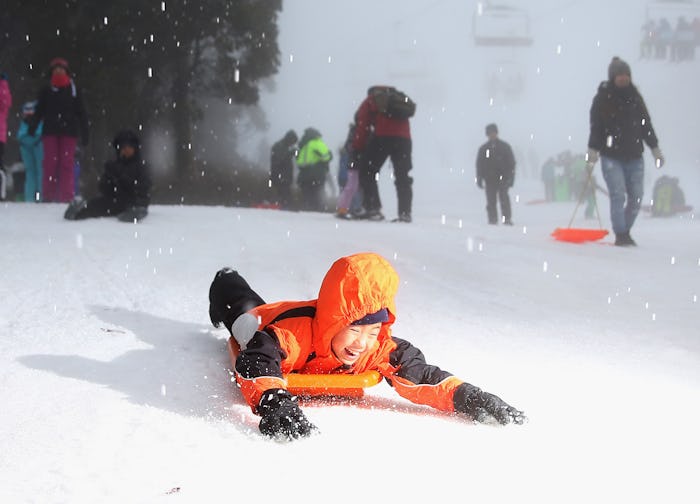News

How Cold Does It Have To Be For Frostbite To Affect Children? Kids Are More Vulnerable
Even though this fall weather has kept us on our toes, shifting from chilly to sweltering in the blink of an eye, frigid and cold winter months are indeed right around the corner. With the cold moving in, plenty of sledding to do, and dozens of snowmen to be built, parents in northern states everywhere are likely thinking back to their own childhoods. It's easy to understand why children can’t resist this sort of outdoor playtime, given how many snowy memories with friends are likely waiting be made. But, in addition to all the fun, parents should also be bracing themselves for the colder temperatures, and how it affects their little ones. So, just how cold does it have to be for frostbite to affect children?
Kids are much more susceptible to frostbite than adults are because heat leaves their skin more quickly, so frostbite can also develop at a faster pace. According to the National Weather Service, frostbite can occur within five minutes of your skin being exposed to temperatures between zero degrees and -19 degrees Fahrenheit. Windchill also plays a big factor in how quickly frostbite can become a risk and this chart by the National Weather Service shows how long you can stay outside in extreme cold temperatures before becoming affected.
The little noses, ears and cheeks on kids are especially vulnerable in this type of weather, so frostbite may develop faster depending on the size of a child and how much of their bodies are covered up. "Even brief skin exposure in high-wind conditions can cause frostbite," Canadian pediatrician Peter Nieman told Today's Parent.
Frostbite can be serious, as it literally means "frozen skin." But there are varying degrees of it, as well as some telltale signs that will relay just how bad it is and how to intervene. According to Today's Parent, in the early stages of frostbite, kids might feel a tingling sensation on the affected skin, which will have a red look to it. As frostbite progresses, the skin will turn a pale yellow color and will still have a soft texture.
"By the time the skin is white, hard and numb, it’s pretty serious," Nieman told Today's Parent. "The skin tissue freezes and there’s a decrease in blood supply to the area. There can also be inflammation, which causes it to be very painful."
Kids might also experience aching pains or numbness, most often on hands, feet, face, and ears, as they are the most difficult to keep covered. So if you think your child is frostbitten, he or she should be seen by a doctor as soon as possible. In the meantime, it's important to re-warm the frostbitten area as soon as possible, but do not rub or massage it because it could damage the skin more.
Even if you and your child are outside only briefly, doctors encourage everyone to dress for the weather in clothing that will keep you warm and dry. Weather experts also recommend wearing waterproof mittens, rather than gloves, in extreme cold weather.
"Dress appropriately, with numerous layers for warmth," Jeffrey Sankoff, an emergency medicine physician in Denver, told ABC News. "Be aware of the wind, as wind chill is a significant issue with lower temperatures."
The best way to avoid any issues with frostbite this winter is to be prepared for it. Keep your child bundled up in lots of layers that will help them stay dry and warm when they're playing outside, and don't be afraid to keep them in if the temperatures drop too low. If their school bus stop is outdoors, ask if you can both wait together inside a trustworthy neighbor's home or sit with them inside the car until the bus arrives. Make sure you know your school's rules for cold weather recess time as well.
Frostbite can be a very serious medical condition, but eliminating some of the risks will also make these winter months worry-free.